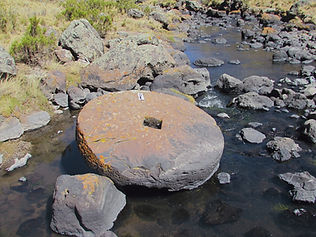
Trapiche Archaeology Project, Puno, Peru
Team archaeologist Javier Chalcha excavating a house floor at the silver refinery of Trapiche. Photograph by Sarah Kennedy.
Marginalized Labor in the Silver Mining Industry
Reconstructing Power and Identity in Colonial Peru
My dissertation investigates the daily life of indigenous laborers at unregulated silver refineries in the Puno Bay. I directed the Trapiche Archaeology Project to study one of these refineries at the household level. Using both archaeological and historical data, I argue that rural silver refineries functioned as locations of economic opportunity for marginalized populations. Through an analysis of local, unregulated economic activities of the 17th and 18th century, I demonstrate how Puno Bay laborers were able to alter their living conditions and take a more active role in the colonial economy. Importantly, these activities occurred over a century before the development of organized trade and labor unions.
Scholarship on colonial silver mining in the Andes has traditionally focused on mining centers such as Potosí, the location of the largest and richest silver mine in the Americas. Less is known about the colonial mining economy at peripheral mining sites, such as the Puno Bay region of Peru, in the western Lake Titicaca Basin, where my research takes place. While deserved attention has been placed on the silver mines themselves, historical sources indicate that equal numbers of workers labored in silver refineries. Referred to as ingenios or trapiches, they were used to grind and process silver ore. Through a complex process at refineries, workers were able to derive pure silver from ore with mercury amalgamation. An enormous number of laborers was needed for this process, hence the instigation of the infamous mita forced-labor draft in the 1570s. Both skilled and unskilled laborers worked in silver refineries, and their roles as conscripted, paid, and self-employed workers changed throughout the period.
Although refineries were ubiquitous on the colonial landscape, we know little about their internal social and economic dynamics. Because they had to be near a water source, they were often some distance from colonial towns and mining centers. They were also ephemeral and used intermittently throughout boom and bust cycles. Refineries provide a unique snapshot of less studied rural colonial life, allowing for an examination of inequality, economic opportunity, and labor at peripheral locations.
My archival research of 17th to 18th century mining ordinances presents an administrative perspective to silver refining. Mining ordinances, such as the Codigo Carolino, reflected problems the colonial administration had within controlling laborers, as well as their attempts to fix these problems, with regulations on labor, food, housing, and productivity. Many ordinances attempted to control kajcheo, a semi-illegal practice where laborers took advantage of rest days to work in mines as self-employed laborers, taking any ore they could find within a certain period for themselves. They refined this ore at unregulated refineries called trapiches, which were small, rudimentary mills that did not contain large stamp-head mallets found in larger, regulated refineries owned by wealthy Spaniards called ingenios.
The owners of trapiches, in contrast to ingenios, were often indigenous or mestizo, and depended heavily on the practice of kajcheo for their refining needs. In the Codigo Carolino ordinances, trapiche owners were forbidden from building refineries and selling refined silver without expressed permission, and they were often accused of illegal activity, such as encouraging the “theft” of the highest quality ore during the kajcheo. These ordinances indicate how difficult it was for Spanish authorities to control this unregulated process, and how it continued in earnest throughout the 18th century.
My excavations at Trapiche Itapalluni confirmed its use as an unregulated trapiche during the 17th and 18th centuries. My archaeological excavations at this refinery concentrated on domestic contexts from households of the refinery laborers, documenting the size and quality of houses, the type of foods consumed on site, and the use of private and public space. My archaeological results reveal that while the architecture and spatial layout of these refineries was restrictive and controlled, access to economic resources, both local and imported, was both equal and accessible for individuals living at the site. These contradictions reveal the fluidity and nuances of daily life within colonial silver refineries.












